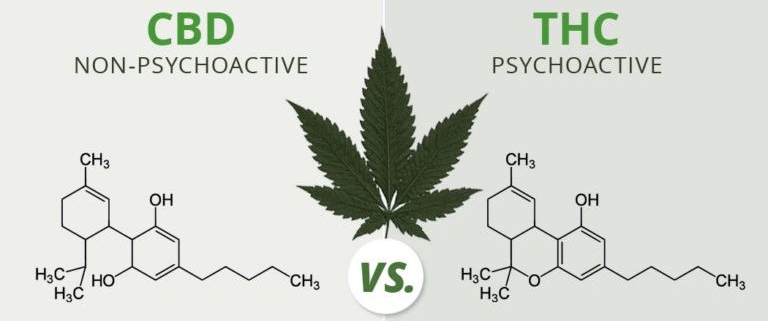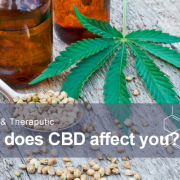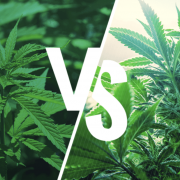What’s the difference between CBD and THC in marijuana?
The amount of THC contained in marijuana is considered the potency or strength that gives the uplifting or hallucinogenic effect. This alone is one of the major factors why consumers use marijuana, and in deciding on a particular cannabis strain for recreational use.
Then you have the medical use of cannabis (aka medical marijuana), and this is where CBD is highly valued and offers a tremendous opportunity to help treat various medical symptoms and conditions, such as pain relief.
Combined in marijuana you have both THC and CBD, and the varying ratios of each working together a particulate strain gives the cannabis strain its unique effect.
There are lots of high-potency marijuana strains available, but there is also an increasing need for less intense products lower in THC and higher in CBD (cannabidiol). Even though both THC and CBD come from cannabis, they’re different in many ways. Knowing the difference can help you decide which strain is best for you. In this post, we’ll cover some of the essential things you should know about the differences between THC and CBD. Let’s start with the medical benefits of marijuana and how its CBD attribute can help with medical ailments.
What are the medical benefits of CBD?
First and foremost, we won’t get into all the medical benefits known today that CBD can offer. Much of the knowledge of what various strains can do in the medical field is still unknown. Due to marijuana’s illegal status in the United States, and before October 2018 in Canada, research and science agencies had very little legal room to experiment and research with marijuana to understand its medical properties (legally that is).
However, now that Canada has legalized marijuana for recreational and medical use, its a gold rush in the medical industry to establish and put the science behind medical marijuana to unlock the natural benefits CBD can offer patients across various medical symptoms and conditions.
We’re going thru a time where more and more research is being performed by scientists on medical marijuana to understand all the benefits (and side effects) from using CBD, or fusing CBD with other medicines. But for those familiar already with the medical magic CBD can offer, here are a few common uses of CBD for patients’ conditions and symptoms:
- Fatigue and tiredness
- Headaches and migraines
- Epilepsy and seizure disorders
- Pain and inflammation
- PTSD and anxiety
- Depression
- Multiple sclerosis
- Opioid withdrawal
CBD strains can be consumed in the same ways as THC strains. You can vaporize or smoke, eat an edible, swallow an oil capsule, rub on a lotion (ex. topicals), or even use a tincture sublingually. Hemp products also contain CBD, but it is less efficient and doesn’t have the same chemical diversity as CBD products that come from cannabis.
Even though medical marijuana has many medical uses for CBD, it’s best known for its effects on a particular type of pediatric epilepsy and seizures.
Dravet’s Syndrome is highly resistant to most treatment methods. The condition is debilitating to patients who may experience up to hundreds of seizures daily. The seizures worsen as patients age, even becoming life-threatening.
CNN produced a documentary on Charlottes Web (watch the video below) that follows a young girl named Charlotte who was given an ingestible oil developed specifically for her needs without giving her the high. Less than two years later, she went from approximately 1,200 seizures a month to about three. This opened the door to start the discussion, and many parents have since spoken out to try and get the same help for their own children.
One of the benefits of CBD is that it has no lethal dose and does not have any known serious side effects. It is still federally illegal, though. In addition, the idea of using cannabis-derived products for pediatric conditions is still a controversial topic because of the stigma of cannabis throughout history.
While CBD is growing at lightening speed in the medical marijuana markets, THC is the popular one that marijuana has become popular among the recreational marijuana community. Why? THC is what gives the high. While THC does deliver that 1, 2 psychedelic punch, it has important benefits, as well.
There is some overlap between what THC and CBD can be used for. However, THC is well-known for being effective in treating nausea, insomnia, appetite loss, and many other symptoms. That’s why many patients use a balance between CBD and THC to get the best effects.
What are high-CBD marijuana strains?
CBD is generally the second-most abundant cannabinoid in cannabis, but not always. There are other ratios, as well. These are the typical ratios available from cannabis:
- High THC, low CBD (e.g.,10-30% THC, trace amounts of CBD)
- Balanced CBD/THC (e.g., 5-15% THC and CBD)
- High CBD, low THC (e.g., 5-20% CBD, THC under 5%)
A strain high in CBD usually give functional effects without the “high” associated with strains high in THC. These types of strains are usually desired by people sensitive to the THC side effects, like paranoia or anxiety. This is also a good type of strain for people who need to control pain, inflammation, or other symptoms throughout the day.
A strain-balanced between CBD and THC gives more of a high than CBD-dominant strains, but they won’t necessarily give the negative side effects like anxiety and paranoia. These are good strains for pain relief. These are also good strains for people who want a mellow buzz but may be sensitive to THC.
The above is just the beginning to understand the difference between CBD and THC in marijuana strains. We’ll share educational content on this topic, but if you have tried various cannabis strains with the varying ratios of THC and CBD for a medical ailment or personal use, please share you experience below in the comments for other readers just learning about the marijuana benefits of THC and CBD.

 POW21.com
POW21.com POW21.com
POW21.com 
 POW21.com
POW21.com
Leave a Reply
Want to join the discussion?Feel free to contribute!